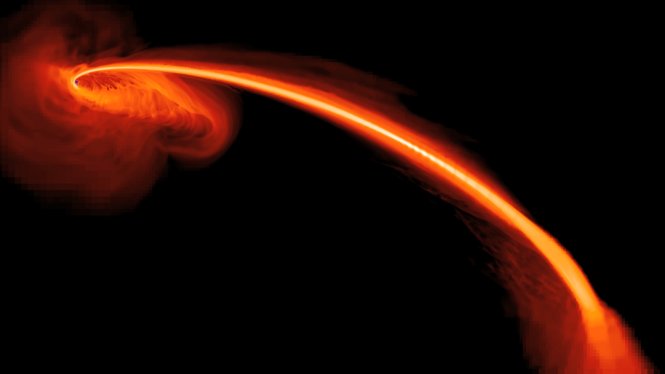We're open daily! View holiday hours
Science News
Black Hole Feeds on Star
May 7, 2012

Ryan Chornock of the Harvard-Smithsonian Center for Astrophysics feels that black holes occasionally get a bad rap. “Black holes, like sharks, suffer from a popular misconception that they are perpetual killing machines,” he says. “Actually, they’re quiet for most of their lives. Occasionally a star wanders too close, and that’s when a feeding frenzy begins.”
Chornock is describing an event captured by telescopes two years ago. A black hole—PS1-10jh, about 2.7 billion light years from Earth—consumed a star, or as NASA’s headline reads, “Black Hole Caught Red-handed in a Stellar Homicide.”
You can see that Chornock has his work cut out for him in reversing misconceptions.
We know that black holes get hungry, but these star feedings are quite rare, only happening every 10,000-100,000 years per galaxy. Telescopes have captured these events, but not quite like this recent one. Astronomers witnessed this violence from start to finish.
If a star passes too close to a black hole, tidal forces can rip it apart. Its constituent gases then swirl in toward the black hole. Friction heats the gases and causes them to glow. By searching for newly glowing supermassive black holes, astronomers can spot them in the midst of a feast.
Chornock and his colleagues discovered just such a glow on May 31, 2010, using the Pan-STARRS1 telescope on Mount Haleakala in Hawaii. The flare brightened to a peak on July 12th before fading away over the course of a year.
“We observed the demise of a star and its digestion by the black hole in real time,” says Harvard’s Edo Berger.
Follow-up observations showed that the black hole was consuming large amounts of helium. Therefore, the shredded star likely was the core of a red giant star. The lack of hydrogen showed that the star lost its outer atmosphere on a previous pass by the black hole.
“This star barely survived one encounter with the black hole, only to meet its unfortunate end in round two,” said Chornock.
The Bad Astronomer explains the details in Discover:
The star apparently orbited the black hole in an elliptical orbit. Over millions or billions of years, the star evolved, and turned into a red giant. Over time, its orbit tightened, and one day it got too close. The enormous tides of the black hole tore the star apart.
More images and video of a computer simulation of the star getting shredded can be found at Universe Today. The findings were published last week in Nature.
Image: NASA, S. Gezari (The Johns Hopkins University), and J. Guillochon (University of California, Santa Cruz)